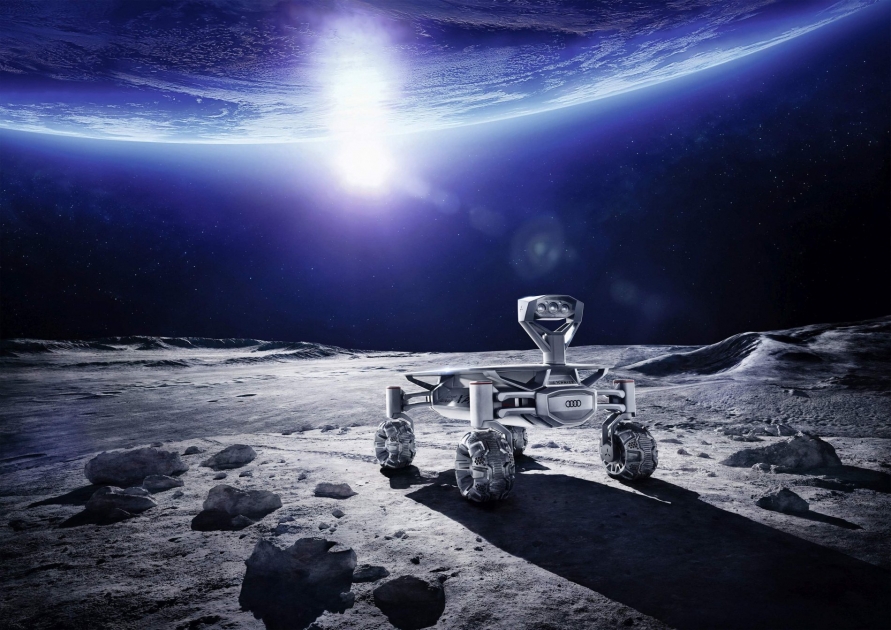
Part-Time Scientists and Audi lunar quattro ready to head for the moon
It has shed eight kilograms in weight, while also gaining Audi e-tron power: Following extensive tests the “Audi lunar quattro” rover is ready to tackle one of the most difficult terrains of all in exploring the Moon. As well as the development of the lunar vehicle, the mission has now also achieved a further landmark: The German space travel team “Part-Time Scientists” announced at Audi City in Berlin that it plans to complete the 385,000 km trip to the Moon from the end of 2017 using a launcher booked with Spaceflight Inc. As an early technology partner and ambassador of the Part-Time Scientists’ mission, Audi has been instrumental in generating extensive publicity for the project and bringing other strong partners on board.
Audi and the German group of engineers announced their partnership in early 2015. Their common objective: to bring together the technological expertise of both partners in getting a rover to travel about on the Moon, under the auspices of the Google Lunar XPRIZE competition. A group of 16 Audi experts has since been supporting the Part-Time Scientists with expertise in a large number of technical areas and has optimized the rover for the lunar mission. Audi was above all able to contribute its quattro experience, knowledge of lightweight construction and expertise in e-tron and design in helping the Berlin team with the development of the unmanned lunar vehicle.
“We are proud that we have given the moon rover important aspects of the four rings’ DNA: It is a quattro, has an e-tron battery on board, drives in piloted mode and offers an intelligent mix of materials,” remarked Michael Schöffmann, Head of Audi Transmission Development and Development Coordinator of the Audi lunar quattro. “The collaboration with the Part- Time scientists is also very enriching for us: We are breaking new technological ground with the Audi lunar quattro and can learn much about how automotive components behave in extreme conditions.”
Over the past few months Audi’s experts have been working on the rover’s intelligent all-wheel-drive power distribution, optimizing its high-performance electronics and contributing their piloted driving expertise to the development process. In order to boost stability and increase the contact surface, the engineers and designers enlarged the rover and its wheels. Meanwhile they reduced its weight from 38 to 30 kilograms by adopting an optimum mix of materials and using aluminum 3D printing. Sophisticated tests, for instance in the Audi sun simulation chamber, were also run to simulate the extreme conditions on the Moon and examine the suitability of the rover’s components.
On the Moon, the Audi lunar quattro will have four cameras to help it find its way around. It will use them to examine objects and take 3D and 360°pictures. One popular motif will be the rover from the Apollo 17 mission, which still stands in the Valley of Taurus-Littrow. ALINA, the landing module of the Part-Time Scientists, will touch down close to the 1972 landing point with two Audi lunar quattro vehicles on board. The probe will travel to the Moon on a launcher such as a Falcon 9 and has a total transport capacity of 100 kilograms. As well as the two rovers, the Part-Time Scientists will therefore also be able to take research equipment to the Moon for other partners. In this context, project partners such as the U.S. space agency NASA, the European Space Agency ESA and Wikipedia were recruited because of their substantial scientific interest in the mission.
The Part-Time Scientists plan to set off for the Moon from late 2017. Before then, they will still need to conduct extensive stress testing of the two Audi lunar quattro vehicles and the landing probe. To that end the team will be simulating the entire mission in the Middle East over the next few months, and is now performing some final fine-tuning.
The Part-Time Scientists came together in late 2008 on the initiative of IT expert Robert Böhme and are based in Berlin. They now number 35 engineers on three continents. Working together with international space experts, their aim is to make the lunar mission become a reality and gather as much knowledge as possible to promote technological development and advance scientific progress.
The Google Lunar XPRIZE, worth more than USD 30 million, is a space travel competition aimed at engineers and entrepreneurs from all over the world. To win, a private team must get a rover on the moon, drive it at least 500 meters and send high-resolution pictures back to earth. From an original field of almost 30 challengers, there now remain five leading teams in the race to head off for the moon. The Part-Time Scientists are the only team from Germany.


























